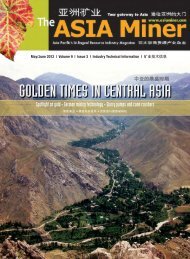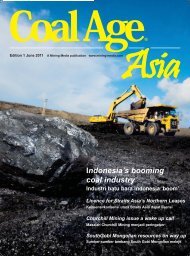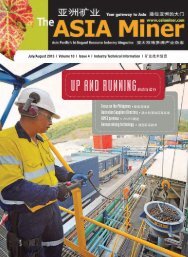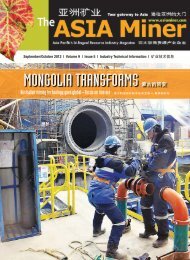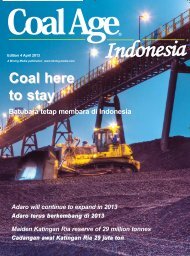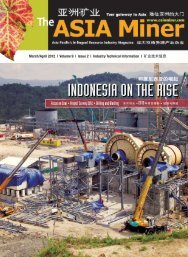MINING WELCOME 欢迎采矿 - The ASIA Miner
MINING WELCOME 欢迎采矿 - The ASIA Miner
MINING WELCOME 欢迎采矿 - The ASIA Miner
Create successful ePaper yourself
Turn your PDF publications into a flip-book with our unique Google optimized e-Paper software.
Central Asia<br />
Kazakhstan world’s largest uranium miner<br />
KAZAKHSTAN’S international energy image<br />
is now that of one of the world’s rising oil exporters,<br />
an extraordinary feat given that, two<br />
decades ago its hydrocarbon output was beyond<br />
insignificant when the USSR collapsed,<br />
and the vast Central Asian nation, larger than<br />
Western Europe, has quietly passed another<br />
energy milestone.<br />
Kazakhstan produces 33% of world’s mined<br />
uranium, followed by Canada at 18% and<br />
Australia with 11% while Kazakhstan contains<br />
the world’s second-largest uranium reserves,<br />
estimated at 1.5 million tonnes. Until two years<br />
ago Kazakhstan was No 3, following Australia<br />
and Canada. <strong>The</strong> trio is responsible for about<br />
62% of global production.<br />
According to Kazakhstan’s State Corporation<br />
for Atomic Energy, Kazatomprom, during<br />
January-September 2011, the country mined<br />
almost 14,000 tonnes of uranium, 11%<br />
higher than the same period in 2010.<br />
Kazatomprom’s revenues also soared 72%<br />
year-on-year. Kazatomprom is the national<br />
operator for the export of uranium, as well as<br />
rare metals, nuclear fuel for nuclear power<br />
plants, special equipment, technologies and<br />
dual-purpose materials. To put this accomplishment<br />
in context, just five years ago Kazakhstan<br />
produced 5279 tonnes of uranium.<br />
While the disaster at Japan’s Fukuhima nuclear<br />
complex caused several European nations<br />
to reassess their commitment to nuclear power,<br />
Kazakhstan’s regional markets seem assured in<br />
Asia’s rising economic powerhouses China and<br />
India. While Beijing reacted to Fukushima by ordering<br />
thorough inspections of nuclear power<br />
plants, China’s Commission of Science Technology<br />
and Industry for National Defence in its<br />
11th Five-Year Plan for the Nuclear Industry announced<br />
China intended to produce 40 gigawatts<br />
of nuclear power electrical generating<br />
capacity within a decade, even though nuclear<br />
power currently accounts for just 1.4% of<br />
China’s electrical power generation.<br />
If China follows through with its nuclear<br />
power plant construction plans the country will<br />
need an estimated 44 million pounds of uranium<br />
annually, as by 2020 the country will have<br />
a total of 77 planned and proposed new reactors.<br />
Of China’s 11 nuclear power plants, the<br />
oldest, Qingshan-1, only came online in 1991.<br />
India’s nuclear ambitions parallel China’s.<br />
While nuclear power accounts for only 3-4%<br />
of the country’s electrical output, India has 19<br />
planned and proposed nuclear power reactors<br />
on the drawing board.<br />
<strong>The</strong> Japanese nuclear crisis has not overshadowed<br />
Astana’s optimism. Speaking at the<br />
Minex conference in Astana, Kazatomprom<br />
president Vladimir Shkol’nik stated that the<br />
Fukushima debacle would not greatly influence<br />
the Kazakh state atomic company’s plans.<br />
Kazakhstan is moving beyond mining of uranium<br />
to producing nuclear fuel rods. On November<br />
4 French Industry and Energy Minister<br />
Eric Besson signed a contract with the Kazakh<br />
government allowing France’s Areva to open a<br />
nuclear fuel plant with Kazatomprom.<br />
A statement from Besson’s office noted,<br />
“This deal commits to the creation in Kazakhstan<br />
of a nuclear fuel production plant dedicated<br />
to the Asian market. <strong>The</strong> construction<br />
of this plant could start as soon as the feasibility<br />
study is completed by the end of the first<br />
quarter of 2012.” According to the agreement,<br />
the facility will consist of a new production<br />
line at Kazakhstan’s ULBA metallurgical<br />
plant that will be 51% owned by Kazatomprom<br />
and 49% by Areva.<br />
And flush with cash, Kazatomprom may buy<br />
into the Russian Federation’s Urals Electrochemical<br />
Integrated Plant, the largest uranium<br />
enrichment facility within Russian State Nuclear<br />
Energy Corporation Rosatom. Rosatom’s CEO<br />
Sergei Kirienko said, “We are involved in purely<br />
technical procedures now, taking into account<br />
the organization and relevant restrictions (of a<br />
closed nuclear facility). We are moving within a<br />
set timetable. We have a plan - to complete all<br />
work in 2012. And we should begin working<br />
with Kazatomprom in 2012.”<br />
In the final quarter of 2011, the International<br />
Energy Agency released its ‘World Energy<br />
Outlook’ which states that if the world<br />
is serious about global warming, it should<br />
consider the continued use of nuclear power<br />
to reduce greenhouse emissions. With<br />
Kazakhstan’s daily oil exports running at<br />
1.74 million barrels and it being the world’s<br />
largest uranium miner, it would seem Astana<br />
is going to continue to rake in the cash no<br />
matter what energy policies the world<br />
adopts in the short term.<br />
—By John CK Daly of http://oilprice.com<br />
Chaarat on track for Tulkubash production<br />
CHAARAT Gold Holdings is on track to begin<br />
production at the Tulkubash deposit of its<br />
Chaarat Gold Project in northwest Kyrgyz Republic<br />
in the second quarter of 2013. <strong>The</strong><br />
company has been encouraged by a 56% increase<br />
in resources to 501,000 ounces.<br />
<strong>The</strong> company has been upgrading the resource<br />
to reserve status and increasing the<br />
overall project size and production rate as well<br />
as carrying out permitting, design and detailed<br />
engineering. Ongoing work also includes infrastructure<br />
development and construction as<br />
well as recruitment and team building.<br />
Exploration has focused on improving the<br />
resource and generating reserves from the<br />
open pittable section of the Central<br />
Tulkubash ore body, both of which provided<br />
encouraging results. This has helped improve<br />
Chaarat’s understanding of the project to the<br />
extent that it believes the resource may have<br />
the capability of supporting a larger daily production<br />
base of 2500 tonnes.<br />
A total of 15,413 metres of drilling generated<br />
an open pittable resource of 404,000<br />
ounces from a total of 501,000 ounces. Further<br />
drill results to the south and north indicate<br />
the reserve can be increased significantly. <strong>The</strong><br />
strike extension and the geometry of the pit<br />
mean production can be increased without<br />
changing the strip ratio and without interrupting<br />
mining activities.<br />
Drilling in the Tulkubash zone suggests that<br />
the mineralized zone extends by a few kilometres<br />
due north and that this extension<br />
should make it possible to significantly increase<br />
production. <strong>The</strong> generation of a feedstock<br />
that is amenable to free milling from a<br />
low strip ratio open pit will provide cash generation<br />
opportunities.<br />
<strong>The</strong> engineering of the process plant has<br />
been mandated to ProMet from South Africa,<br />
which is affiliated to a large Chinese engineering<br />
and construction company, Dadi Engineering.<br />
As such a large part of the detailed<br />
design work is being executed in China.<br />
46 | <strong>ASIA</strong> <strong>Miner</strong> | January/February 2012



